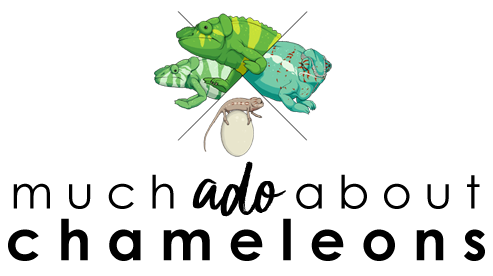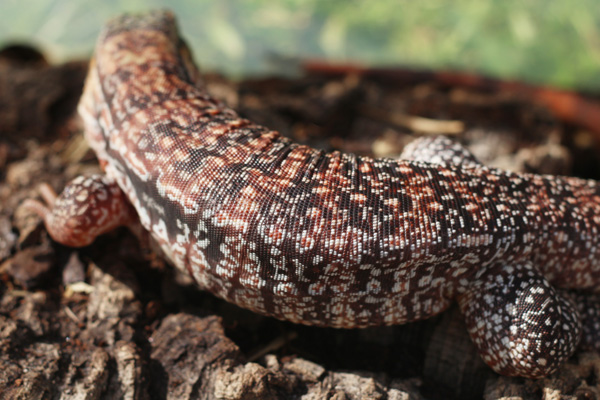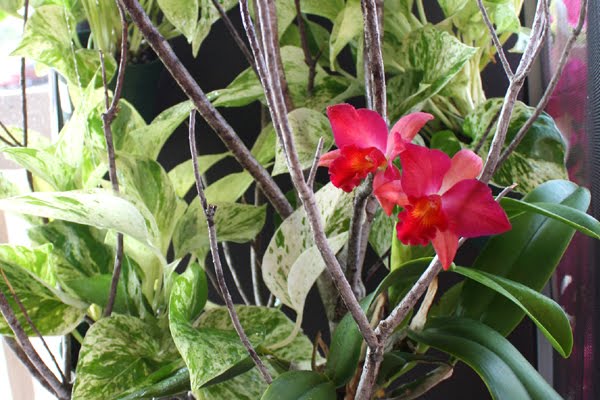This is Part II in my three part documentation of my first successful panther chameleon breeding. This one will focus primarily on the eggs, from beginning to end, the changes they underwent, and how I went about caring for the clutch as it developed.
Following the successful mating on November 28, 2011, the female laid 24 eggs on December 18-24, 2011 while I was out of town, just shy of 4 weeks after mating. She laid the eggs in a plant pot that measures 13" deep by 11" across at the top, filled to the top with moist, organic potting soil. She buried them all the way at the bottom of the pot, as is typical.
*NOTE - Females need somewhere to dig and bury their eggs when they are ready or they will succumb to a condition known as egg-binding, in which the female is no longer able to lay the eggs and will die unless immediate veterinary assistance is provided. Not enough calcium in the diet and other nutritional/health issues will also prevent a female from laying eggs. Refer to Part I of this breeding blog series for more information.
I very carefully and slowly scooped dirt from the laying pot until I uncovered the first egg. Then, with a sterilized set of tweezers I began removing each egg and placing it in the incubating container the way in which it was laid (that is, I do not roll them around). I used tweezers because the oil on your fingers can clog the outside of the egg and make air exchange difficult or impossible. Powder-free gloves are also good. I continued this process until every egg was excavated and they were all neatly lined up in the laying container.
THE CONTAINER - Something like a tupperware container with a tight lid will work the best for incubating the eggs. It does not need to be a very deep one, so the kind that are used to store sandwiches are generally the best. The incubating medium can be something like vermiculite, perlite, or Superhatch, etc. but it all needs to be moistened to the point where you can only squeeze a single drop or two from a fist of it. This will keep the humidity high in the container. A pin hole can be made in the container for air exchange but you can also simply open it once every few weeks for a moment. You may have to re-mist the media to maintain the humidity very high (but do not spray the eggs directly).
 |
| December 28 - Just a few days after being buried in soil, I dug them up and placed them in the incubating container with moist vermiculite. |
The rest is just waiting, unfortunately!
Lots and lots of waiting....
 |
The eggs after 4 months of incubation. They have grown a little bit! |
 |
| This photo and the one above show the eggs at 5 months of incubation, first compared in size to an American quarter and then with a 50c Euro, for my European friends and readers. |
 |
| Here are the eggs at 7 months of incubation. One egg has dramatically increased in size, for unknown reasons. |
 |
| By month 9 of incubation, the eggs are showing much more dramatic signs of hatching. The eggs are starting to show crackling and transparency, both of which are good signs. |
But because this is not the part that deals with babies (or neonates), we will continue to see how the remaining eggs changed and developed as more hatchlings emerged. On October 8, just 2 days following the hatching of the first baby, the remaining eggs underwent more dramatic changes. It is recommended to leave any hatchlings in the bin with the eggs for a short while before being removed, as it is believed that the hatchlings must signal the others to hatch by some method not yet understood - it may be pheromones or it may just by touch, but it seems to help move things along.
So on October 8 several of the eggs began to sweat and others became much more transparent.
 |
| On October 8 a second baby pips the egg shell and sits, waiting to emerge completely. |
By October 11, several more babies have hatched and the ones that are about to look more and more transparent. A couple towards the top shrank and hardened, which in this case meant that the eggs weren't going to hatch.
NOTES.
- In the case of this clutch, some of the eggs did shrink and harden, and then not hatch. Of the 24 eggs I had at the beginning, 3 proved not to be fertile. Upon dissection of some of these hardened eggs some had fully-formed babies that never hatched and others were duds, full of yellow jelly. Why these eggs never hatched probably had to do with the humidity perhaps not being as high as it should have been. I may have been able to help them survive had I cut the eggs open myself but I didn't want to for two reasons: 1. I did not want to risk injuring the babies in the process, since they are so tiny. My scalpel could have cut them and injured them seriously if my hand slipped or was not gentle enough. And 2. because I did not want to help hatchlings that perhaps just weren't strong enough to survive, when the other half of the eggs hatched quickly and without help.
- It was recommended to me that empty egg shells remain in the container with the others, perhaps because they release pheromones or other signals that stimulate the other eggs to hatch.
If I had to do this over again, there are a few things I would change slightly to improve my hatch rate. But at this time I am pleased with the very manageable number of hatchlings that resulted from this clutch, which means that I will be less overwhelmed when learning how to raise and care for them until they go to their new homes.
Part III, on raising the hatchlings, will follow shortly.
















Your website is excellent--I've just received some unusual and beautiful Jewelled chameleons and am going to attempt to breed them successfully. I believe the female is gravid. I've bred panther and veiled chams but this will be a first for Jewelled chams (Furcifer campani). Keep up the good work.
ReplyDeleteThank you Sam! Good luck, campani is a beautiful species that we really should see more of!
DeleteI have three questions that are unanswered here.( I may have others Later) My wife found some eggs that were laid in the grass the correct size and shape I have coconut fiber substrate, and here goes Nothing.
DeleteI have successfully hatched a Gold dust Day Gecko,it is a month old and doing Very well.
I Live in Maui Hi.
Now my questions are: Why does the container need to be sealed tight with only pin holes??
will the coconut fiber work as well as it did for my Gecko? I know they are Very different.
I kept the Fiber substrate dry until it hatched, Then I moistened it and and keep the habitat misted. In this case I need to keep the substrate damp for the eggs. How do I Regulate the temp with Damp substrate?
This comment has been removed by the author.
ReplyDeletevery helpful thank you for taking the time to write this
ReplyDeleteThank you! I'm glad to hear it was useful.
DeleteHi Olimpia,
ReplyDeleteWhat lighting heat source do you use for your newly hatched babies and what UVB is the light source?
Many thanks
Darren
Hi Darren,
DeleteFor heat I use a 15-20w incandescent bulb set on one far side of the baby-rearing tub and and for UVB I will use an older Reptisun 10.0 fluorescent and if the weather allows I will take the cage/tub outside a few hours for natural sunshine.
Hi Olimpia I was wondering if your chameleon can get lonly because when i bought him he was with other chameleons and now hes by him self and seems sad .
ReplyDeleteThis comment has been removed by a blog administrator.
ReplyDeleteI've never raise a chameleon before, but after I read this post I guess I should raise one. Thanks for your post.
ReplyDeleteGreat post. My bestfriend is going to raise chameleon, and she will need your article. Thank you.
ReplyDeleteHi, great presentation! I totally failed at my first attempt, probably due to too much adding of water. But out of the 30 plus eggs on the second attempt. I was able to get a 85% hatching. I ended up with about 28 babies. But really messed up on the hatchling care by once again allowing the 10 gallon tank to get too much moisture and lost all but 9 babies, which i just sold. I am not going to attempt this again, even though i had learned a lot about proper care. I just felt so bad about not learned before hand on the proper care of both the incubating eggs and aftercare. Im going to hand deliver these last 40 plus eggs to another chameleon breeder because i just cant handle risking to lose any more chams due to my neglegence. If i were to suggest anything to people wanting to attempt a breeding program. This would be the page i would suggest that everyone learns from, as i was reading too many pages and getting confused and everything your explaining is exactly what i should have done to have been much more successful. Keep the temps as hr suggest, weigh your containets once u have them properly established in order to make sure your moisture levels do not drop too much or get too much moisture added. Keep it dark ( closet or drawer) minimul airflow. Maybe 1-3 very small pinholes on top. And my last batched very well at about 74-76 degrees farenheight. Then try to use open air cages that can be kept warm and dry, with very small amounts of misting to ensure that. Lots of fruit flie cultures available around hatching time, and u will do much better than i did. Every baby i lost was a big feeling of failure! So trust one persons guidance and stick to their method if yheir showing a good success rate, like this person
ReplyDeleteThanks again. Wish i had found u sooner!